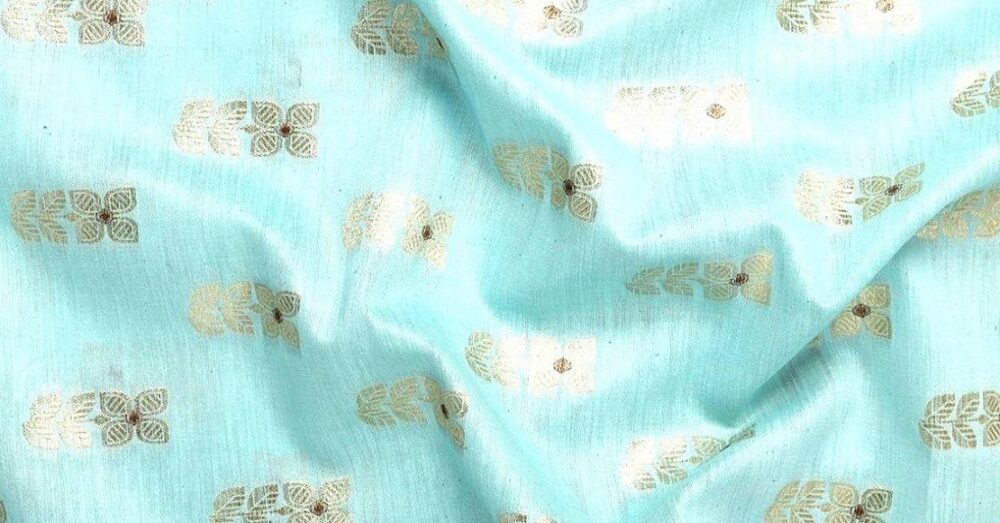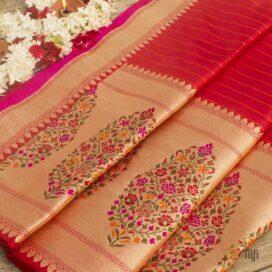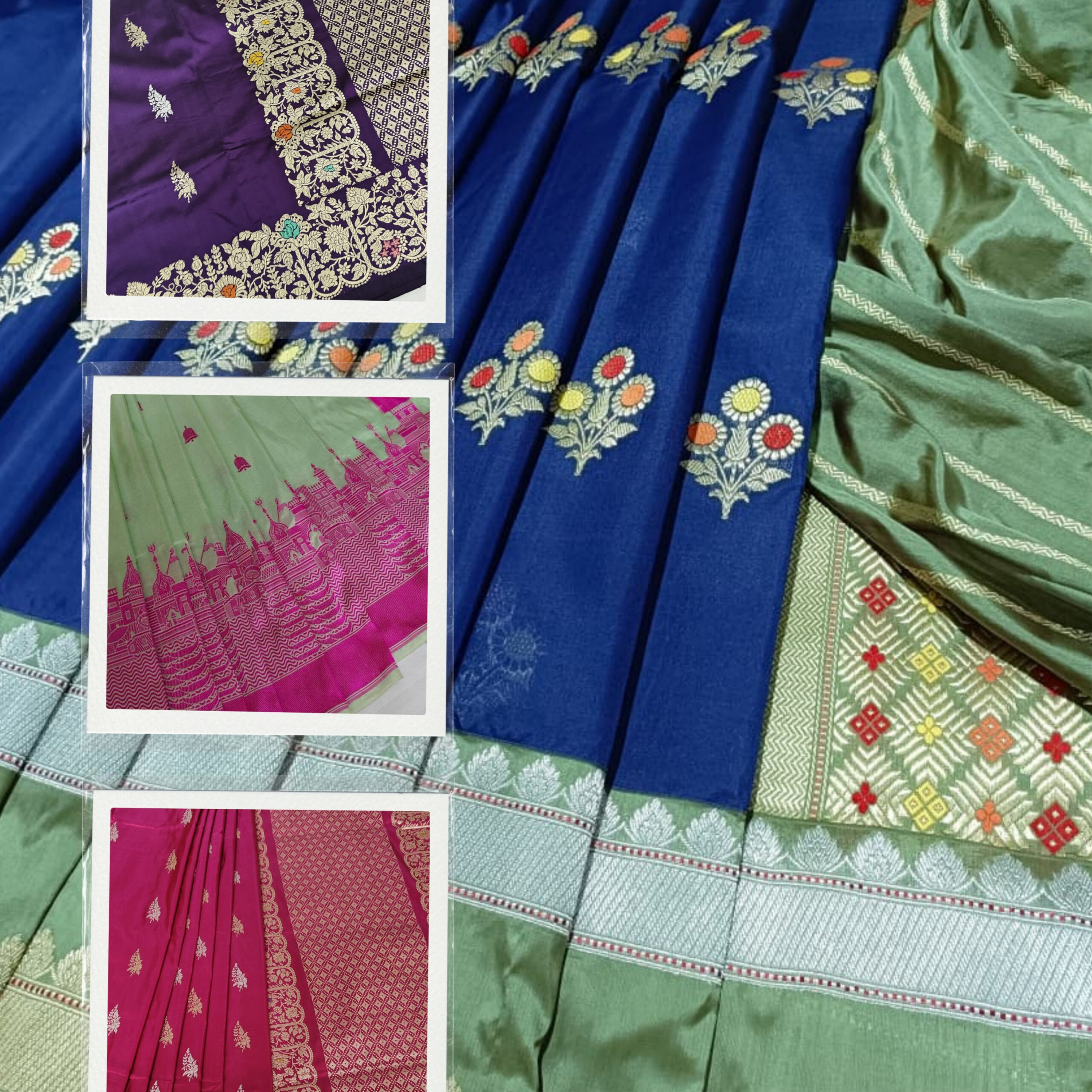- You have no items in your shopping cart
- Subtotal: ₹ 0

Imagine walking into a store and watching a craftsman work with gleaming gold threads, as he peers over a rickety handloom, using techniques that are almost as old as time itself. Each of these Banarasi sarees, he says, takes him anywhere from two weeks to six months to complete. The know-how has been passed down to him from his forefathers. It is one that he learned simply by watching his family when he was just a boy. In the 21st century, this scene may seem like it belongs to a black-and-white reel played in a museum. But this ancient craft of weaving Banarasi silk sarees can still be glimpsed in a handful of silk emporiums in Varanasi.

Origin and history
Historians have been able to trace silk work to Vedic times. Hiranya – literally translated as cloth made from gold – finds mention in the revered Rig Vedas as the attire of the Gods. And some scholars believe that this description comes close to the embellished zari work, synonymous with Banarasi silk sarees. The timeless Jataka Tales and Pali texts support the evidence of a bustling cloth trade on the banks of the holy Ganga, in Kashi.
There’s no debating the fact that Banaras has been an important centre for weaving since time immemorial. But it was Mughal Emperor Akbar who gave the weaving industry, here and across India, a shot in the arm. The emperor who was known for his love of the finer things in life – Persian wine, his gem-crusted sword with crusted elephants, his sarpech (turban ornament) which consisted of large emeralds in elaborate floral motifs, and more – also loved zari work (embroidery in pure gold). He had many of his wives and those from his harem wrapped in rich silk sarees with zari work. And this is what we today popularly refer to as Banarasi silk, while also adding silver threadwork to the mix.
Emperor Akbar so loved the silk work that he didn’t limit its use to clothing and even had his palace draped in it – carpets and wall hangings made from Banarasi silk. Little wonder that centuries later, the British colonizers too were baffled by this intricate handicraft. But it was post independence that several small scale industries grew in the region and Banarasi silk became much sought after.

Weaving process
I visit Bressler Silk House in Hukul Gunj, where a loom sits at the very entrance with resham threads running through the length and breadth of the machine. Ojha, of Bressler Silk House, explains how zari threads are made: flattened thin metallic strips are drawn from gold alloys. These delicate strips are then wound around silk yarns. The threads are then flattened using machines. Often they are passed through a brightener to increase their sheen.
While motifs are crafted out of zari threads, the rest of the saree is usually made of silk that is dyed in a variety of colours. In recent years, natural dyes are gaining popularity due to concerns of the sacred Ganga being polluted from chemical dyes, as dye manufacturing units populate the area.

Special features
The saree designs are first created on paper: the pattern is literally punched into paper, making it look much like Braille. A separate pattern guides each row and hundreds of such patterns, (naksha patras), are created for a single saree.
It is essentially these patras that give you everything from floral motifs to jali work and more. Based on these patras the dyed silk and zari threads are wound into the handloom, to create the desired patterns. Given the effort, the sarees often come with a hefty price tag. And sarees produced on handlooms can take anywhere from a 15 days to a month, and sometimes upto six months.
Today power looms are replacing the hand-loom, and cutting down on labour and production time. But the final machine-made product is uniform, and lacks the distinctiveness of the handmade saree.
Shop for exquisite Banarasi sarees.
You Might Also Like: North Indian Sarees For The Woman Who Loves Her Six Yards

Colours
Banarasi sarees are available in a host of colours and are known more for the gold and silver zari work that adorns them.
Motifs
Back in the Mughal era, the designs on Banarasi sarees largely consisted of Islamic motifs such as floral patterns, stylised leaves, and the use of jali work (net), all of which can also be found also in their architecture. The Taj Mahal boasts of similar motifs in intricate inlay work crafted from and within stone. The effect is simply stunning. The designs were an attempt to recreate the bounty of jannat (paradise).
During the British era, the Victorians often demanded geometric patterns. Today, while Islamic motifs remain popular, one can find a variety of Hindu Gods embossed on to cushion covers, wall-hangings and even sarees.

Varieties
Banarasi sarees can be categorized into four distinct varieties, namely pure silk (katan), organza (kora) with zari and silk, georgette and shattir. Of these, the pure silk variety is the most renown. On the basis of design, Banarasi sarees are also classified into jangla, tanchoi, vaskat, cutwork, tissue and butidar.
Shop different varieties of Banaras sarees.
Current state of the art
The trade that has survived centuries is under threat with inexpensive fakes flooding the markets. Sadly, many craftsmen have been forced to switch careers. An authentic Banarasi silk saree takes time and effort to create, and comes with a hefty price tag. Customers are often unwilling to pay the price of the labour and willingly opt for fakes. But a visit to Bressler Silk House, a talk with a craftsman, and watching him at work, is all it will take to realise the intricacy and beauty of this art. By respecting the craftsman and paying a fair price, we may be able to preserve this chapter of our history.
On the bright side, Banarasi sarees now have the GI (Geographical Indication) certification for Banaras Brocades and Sarees.

Price range
A genuine Banarasi silk saree can be bought for anywhere from Rs.3,000 to Rs.2,00,000 depending on the design and the intricacy of the work. That said, a saree with a decent amount of work would cost a minimum of Rs.8,000 to Rs.10,000.
How to identify a Banarasi silk saree
- With increase in prices of gold and silver, copper alloys are used to create zari threads. These threads are then plated in silver or gold. “But the trained eye can immediately spot the difference,” says Ojha. He shows me a fake against the real deal and while the former has more glitter, the garishness takes away from the regal air.
- An easy way to spot a fake is to look for heavy thread work on the reverse side of the saree. But while these are indicators, they can often be manipulated by crafty salesman.
- To absolutely ensure that you aren’t being scammed, look for the GI (Geographical Indication) tag. This government marker protects customers and craftsmen.
Care guide
It is recommended that you dry clean Banarasi sarees. However, if you choose to wash it at home, make sure to simply dip it in cold water a few times before hanging out to drip-dry. Do not use detergent in the first few washes and a clothes brush is an absolute no-no. You can either wrap the saree in muslin cloth and store it away from sunlight or store it in a hanging position in your cupboard. Either way, you must change the folds every now and then.
Images credit: Kiran Mehta / Shutterstock






Made in Varanasi Handlooms. Varanasi Sarees, Varanasi Dupatta & Pre cut Fabric. Genuine and Economical Pricing & Best Quality Products. Handpicked Selections.
Prithacrafts beings you charming and lavish collection for you to wear premium clothing which has been master crafted by skilled makers of Varanasi India An exquisite range of unseen handcrafted treasures.
I am in love with Banarasi Silk Fabric Suit. Go for it. Highly Recommended
Prithacrafts beings you elegant and lavish collection for you to wear premium clothing which has been master crafted by skilled makers of Varanasi India.
Perfect Traditional Indian Wear. Kudos to Prithacrafts Team and their manufacturing unit